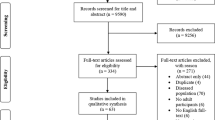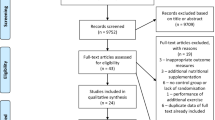Abstract
Introduction and hypothesis
The purpose of this study is to determine whether a Pilates exercise program and a pelvic floor muscle-training (PFMT) program could provide similar improvements in pelvic muscle strength.
Methods
Sixty-two women with little or no pelvic floor dysfunction were randomized to Pilates or PFMT. Each group had 24 biweekly 1-h sessions with either a physical therapist or Pilates instructor. Strength was measured via perineometry (cmH2O). Two questionnaires—pelvic floor distress inventory (PFDI-20) and pelvic floor impact questionnaire (PFIQ-7)—were also collected.
Results
At baseline, the Pilates and PFMT groups measured 14.9 ± 12.5 and 12.5 ± 10.4 cmH2O, respectively (p = 0.41). Both the Pilates and PFMT groups got stronger (6.2 ± 7.5 cmH2O, p = 0.0002 and 6.6 ± 7.4 cmH2O, p = 0.0002, respectively), with no difference between groups p = 0.85. PFIQ and PFDI scores improved from baseline but not between groups.
Conclusions
Further study is required to determine if Pilates can actually treat pelvic floor dysfunction.

Similar content being viewed by others
References
Rogers R (2008) Urinary stress incontinence in women. N Engl J Med 358(10):1029–1036
Bradley CS, Zimmerman MB, Wang Q, Nygaard IE (2008) Vaginal descent and pelvic floor symptoms in postmenopausal women: a longitudinal study. Obstet Gynecol 111(5):1148–1153
Shamliyan TA, Kane RL, Wyman J, Wilt TJ (2008) Systematic review: randomized, controlled trials of nonsurgical treatments for urinary incontinence in women. Ann Intern Med 148(6):459–473
Bo K (2006) Can pelvic floor muscle training prevent and treat pelvic organ prolapse? Acta Obstet Gynecol Scand 85:263–268
Glazner LM, Herbison GP, MacArthur C et al (2005) Randomised controlled trial of conservative management of potential urinary and fecal incontinence: six year follow up. Br Med J 330:337
Klarskov P, Nielsen KK, Kromann-Andersen B, Maegaard E (1991) Long-term results of pelvic floor training for female genuine stress incontinence. Int Urogynecol J Pelvic Floor Dysfunct 2:132–135
Bo K, Kvarstein NI (2005) Lower urinary tract symptoms and pelvic floor muscle exercises after 15 years. Obstet Gynecol 105(5):999–1005
Agur WI, Steggles P, Waterfield M, Freeman RM (2008) The long-term effectiveness of antenatal pelvic floor muscle training: eight-year follow up of a randomized controlled trial. BJOG 115(8):985–990
Sluijs E, Kok G, Zoe J (1993) Correlates of exercise compliance in physical therapy. Phys Ther 73:771
Latey P (2001) The Pilates method: history and philosophy. J Bodyw Mov Ther 5(4):275–282
Lately P (2002) Updating the principles of the Pilates method—Part 2. J Bodyw Mov Ther 6(2):94–101
Bump R, Mattiasson A, Bo K, Brubaker L, DeLancey J, Klarskov P (1996) The standardsiation of terminology of female pelvic organ prolapse and pelvic floor dysfunction. Am J Obstet Gynecol 175:10–17
Barber MD, Walters MD, Bump RC (2005) Short forms for two condition-specific quality of life questionnaires for women with pelvic floor disorders (PFDI-20 & PFIQ-7). Am J Obstet Gynecol 193(1):103–113
Bo K, Talseth T, Home I (1999) Single blind, randomized controlled trial of pelvic floor exercises, electrical stimulation, vaginal cones and no treatment in management of genuine stress incontinence in women. BMJ 318:487–493
Sapsford R, Hodges P (2003) Contraction of the pelvic floor muscles during abdominal maneuvers. Arch Phys Med Rehabil 2001(82):1081–1088
Bo K (2003) Pelvic floor muscle strength and response to pelvic floor muscle training for stress urinary incontinence. Neurourol Urodyn 22(7):654–658
Oyama IA, Rejba A, Lukban JC et al (2004) Modified thiele massage as therapeutic intervention for female patients with interstitial cystitis and high-tone pelvic floor dysfunction. Urology 64(5):862–865
Culligan PJ, Blackwell L, Murphy M, Ziegler C, Heit MH (2004) A randomized, double-blind, sham-controlled trial of postpartum extracorporeal magnetic innervation to restore pelvic muscle strength in primiparous patients. Am J Obstet Gynecol 192:1578–1582
Cochrane library (2006) Issue 1, Article No.: CD005654. doi:10.1002/14651858.CD005654
Hay-Smith J, Morked S, Fairbrother KA, Herbison GP (2008) Pelvic floor muscle training for prevention of urinary and faecal incontinence in antenatal and postnatal women. Cochrane Database Syst Rev 8(4):CD007471
Brostrom S, Lose G (2008) Pelvic floor muscle training in the prevention and treatment of urinary incontinence in women: what is the evidence? Acta Obstet Gynecol Scand 87:384–402
Brubaker L, Shott S, Tomezsko J, Goldberg RP (2008) Pelvic floor fitness using lay instructors. Obstet Gynecol 111(6):1298–1304
Hollis S, Campbell F (1999) What is meant by intention to treat analysis? Survey of published randomized controlled trials. BMJ 319:670–674
Conflicts of interest
None.
Author information
Authors and Affiliations
Corresponding author
Additional information
This study was funded through the Atlantic Health Division of Urogynecology and Reconstructive Pelvic Surgery. In addition, vaginal sensors were donated by The Prometheus Group, Dover, NH, USA.
Rights and permissions
About this article
Cite this article
Culligan, P.J., Scherer, J., Dyer, K. et al. A randomized clinical trial comparing pelvic floor muscle training to a Pilates exercise program for improving pelvic muscle strength. Int Urogynecol J 21, 401–408 (2010). https://doi.org/10.1007/s00192-009-1046-z
Received:
Accepted:
Published:
Issue Date:
DOI: https://doi.org/10.1007/s00192-009-1046-z




